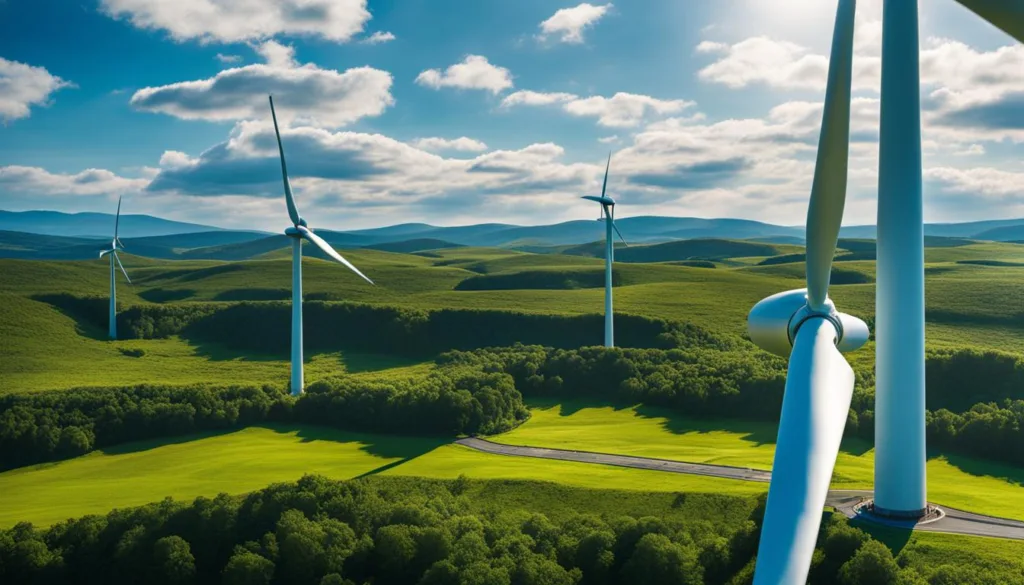Welcome to an exploration of how we can create a greener future for our planet and future generations. On this Earth Day, let’s challenge ourselves to think beyond the usual and take actionable steps towards a more sustainable and eco-friendly lifestyle. Are you ready to embark on this journey with us?
Earth Day, celebrated globally every 22nd April, is a reminder of the significance of environmental awareness and the urgent need for climate action. It is a call to action for each one of us to contribute to the sustainability of our earth. By adopting eco-friendly practices and making conscious choices, we can make a real difference in conserving our environment.
Join us on this adventure as we share practical tips and insights on how to live sustainably, reduce waste, conserve energy, and embrace renewable resources. Together, let’s make every day Earth Day!
Key Takeaways
- Earth Day encourages us to raise awareness about environmental issues and take action toward conservation.
- Living an eco-friendly lifestyle involves rethinking consumption and waste, conserving energy, and embracing renewable resources.
- Water conservation plays a crucial role in preserving aquatic ecosystems and ensuring a sustainable future.
- Choosing sustainable transportation options and supporting local businesses can significantly impact our environment.
- Promoting environmental awareness through advocacy, education, and connecting with nature is vital for a greener future.
Understanding the Significance of Earth Day
Earth Day is a significant global event that reminds us of the importance of protecting our planet and taking action to address environmental challenges. It serves as an annual reminder for individuals, communities, and governments to come together and raise awareness about issues such as pollution, deforestation, and climate change. This global event brings people from all walks of life together to highlight the urgent need for environmental awareness and sustainability.
Making Every Day Earth Day with Sustainable Living Practices
Adopting sustainable living practices is a powerful way to make every day Earth Day and minimize our impact on the environment. By reevaluating our consumption habits, conserving energy, and embracing renewable energy solutions, we can contribute to a more sustainable future for the planet.
Rethinking Consumption and Waste
One of the key aspects of sustainable living is rethinking our consumption patterns and reducing waste. By making conscious choices, such as opting for reusable products instead of single-use items, we can significantly reduce our ecological footprint. Sustainable living encourages us to prioritize quality over quantity and to be mindful of the resources we consume.
Reducing waste also involves proper recycling and composting. By segregating our waste and recycling materials, we contribute to the circular economy, where materials are reused instead of being discarded. Additionally, composting organic waste allows us to divert it from landfills and create nutrient-rich soil for gardening.
Energy Conservation Measures at Home
Conserving energy is another crucial aspect of sustainable living. By implementing energy conservation measures at home, we can reduce our greenhouse gas emissions and decrease our dependence on non-renewable energy sources. Simple steps such as switching to energy-efficient appliances, turning off lights and electronic devices when not in use, and properly insulating our homes can make a significant difference.
Investing in smart thermostats, solar panels, and LED lighting can further enhance our energy conservation efforts. These technologies help us optimize energy usage and make the most of renewable energy sources. Embracing energy-saving habits not only benefits the environment but also lowers our utility bills, making it a win-win situation.
Embracing Renewable Energy Solutions
Transitioning to renewable energy sources is a powerful way to combat climate change and reduce our carbon footprint. Embrace renewable energy solutions such as solar power, wind energy, and geothermal systems can help us achieve a more sustainable future. By generating clean energy on-site, we can significantly reduce our reliance on fossil fuels and contribute to a cleaner, greener planet.

In conclusion, making every day Earth Day involves rethinking consumption and waste, implementing energy conservation measures at home, and embracing renewable energy solutions. By adopting sustainable living practices, we can create a positive impact on the environment and inspire others to do the same. Let’s prioritize sustainable choices and work together towards a greener future for our planet.
How to Save Water and Protect Aquatic Ecosystems
Water conservation plays a crucial role in preserving aquatic ecosystems and ensuring the availability of water for future generations. By adopting sustainable water usage practices, we can make a significant positive impact on the environment. Here are some practical tips and strategies to help you save water in your daily lives:
Fix leaks promptly: Even a small leak can waste a significant amount of water over time. Regularly check and repair any leaks in faucets, pipes, or toilets to prevent unnecessary water wastage.
Using low-flow fixtures: Install water-efficient fixtures such as low-flow showerheads, faucets, and toilets. These fixtures are designed to conserve water while still providing adequate functionality.
Drought-resistant landscaping: Consider opting for drought-resistant plants in your garden or lawn to minimize water usage. These plants are well-suited to dry climates and require less irrigation, reducing the strain on water resources.
Collect and reuse rainwater: Utilize rain barrels or other collection systems to capture rainwater for watering plants or cleaning purposes. This reduces the need for tap water and helps to conserve a valuable resource.
By incorporating these simple practices into our daily routines, we can contribute to the protection and preservation of our planet’s water resources. Let’s work together to ensure the sustainability of our aquatic ecosystems for generations to come.
The Impact of Sustainable Transportation Choices
Sustainable transportation choices play a crucial role in reducing carbon emissions and improving air quality. By opting for eco-friendly modes of transportation, we can contribute to a greener future for our planet.
Benefits of Walking, Cycling, and Public Transit
Walking and cycling are not only great for our physical health but also for the environment. By choosing to walk or cycle for short distances, we reduce our reliance on cars and decrease traffic congestion. Public transit, such as buses and trains, provides an efficient and sustainable way to commute, reducing the number of individual vehicles on the road.
“Walking is a simple and accessible mode of transportation that allows us to stay active while minimizing our carbon footprint.” – Jane Smith, Environmental Advocate
Walking, cycling, and using public transit have additional benefits, including:
- Reduced air pollution and greenhouse gas emissions
- Improved physical fitness and mental well-being
- Cost savings on fuel and parking
- Less traffic congestion and shorter commute times
Transitioning to Electric and Hybrid Vehicles
Another sustainable transportation option is the use of electric and hybrid vehicles. These vehicles run on electricity or a combination of electricity and fuel, significantly reducing greenhouse gas emissions compared to traditional gasoline-powered cars. Electric vehicles (EVs) produce zero tailpipe emissions, while hybrid vehicles combine an electric motor with a gasoline engine for improved fuel efficiency.
Transitioning to electric and hybrid vehicles not only helps reduce our carbon footprint but also supports the development of cleaner and more sustainable transportation systems. As the technology continues to advance, the accessibility and affordability of electric and hybrid vehicles are increasing, making them a practical choice for environmentally conscious individuals.
Support Local: How Our Choices Affect the Global Environment
When it comes to making a positive impact on the global environment, our choices matter. By supporting local businesses and embracing sustainable agriculture practices, we can contribute to a healthier planet for future generations.
The Value of Community Markets and Organic Produce
Community markets play a vital role in creating a sustainable and interconnected community. By shopping at these markets, we support local farmers and small businesses, providing them with the opportunity to thrive. Additionally, community markets offer a wide range of organic produce, which is not only beneficial for our health but also for the environment.
Organic produce is grown without the use of harmful pesticides and synthetic fertilizers, ensuring that our food is free from chemical residues. By choosing organic, we contribute to the preservation of soil quality, the reduction of water pollution, and the protection of biodiversity.
The Role of Farmers and Sustainable Agriculture
Farmers play a crucial role in sustainable agriculture practices. Through their dedication and commitment to sustainable techniques, they promote soil health, conserve water resources, and reduce carbon emissions. By supporting local farmers and buying their products, we encourage the continuation of sustainable farming practices.
Sustainable agriculture focuses on the long-term viability of farming while minimizing the negative impact on the environment. It involves methods such as crop rotation, natural pest control, and efficient water management. By supporting sustainable agriculture, we help preserve ecosystems, promote biodiversity, and reduce greenhouse gas emissions.
Together, we can make a difference by choosing local, supporting community markets, and embracing organic and sustainable agriculture practices. Let’s connect with our local communities, protect the environment, and create a better future for our planet.
Advocacy and Education: Promoting Environmental Awareness
Promoting environmental advocacy and education is vital for driving positive change and fostering a culture of sustainability. By raising awareness about environmental issues, we can inspire individuals and communities to take action and make a difference. Through knowledge sharing and supporting eco-friendly policies, we can contribute to a more environmentally conscious society.
One powerful way to promote environmental awareness is through advocacy. This involves actively supporting and promoting initiatives that protect our planet, such as participating in grassroots campaigns, contacting elected officials, and joining environmental organizations. By lending our voices to these causes, we can amplify the message and encourage governments and corporations to prioritize sustainable practices.

Education plays a crucial role in nurturing environmental consciousness. By providing individuals with the knowledge and tools to understand and address environmental challenges, we empower them to make informed decisions in their daily lives. Environmental education can take many forms, from school curricula that include sustainability topics to workshops and community programs that teach practical skills for sustainable living.
“Education is the most powerful weapon, which you can use to change the world.” – Nelson Mandela
When we promote environmental awareness, we inspire others to take action and adopt environmentally friendly behaviors. This ripple effect can lead to collective change and have a significant impact on conservation efforts. By emphasizing the interconnectedness of human welfare and a healthy environment, we can motivate individuals to make choices that benefit both themselves and the planet.
Connecting with Nature as a Path to Conservation
When it comes to conserving our planet, connecting with nature is a powerful tool that can inspire us to take action. Spending time in the great outdoors allows us to develop a deep sense of appreciation for the environment and the delicate balance of ecosystems. It reminds us of our responsibility to protect and preserve the natural spaces that sustain us.
Volunteering for Green Causes and Local Clean-Ups
One impactful way to connect with nature is by volunteering for green causes and participating in local clean-up events. By joining forces with like-minded individuals in our community, we can actively contribute to the conservation efforts in our area. Whether it’s picking up litter in our local parks or participating in habitat restoration projects, we have the power to make a difference. Not only does volunteering help improve the environment, but it also allows us to form valuable connections with others who share our passion for conservation.
Inspiring Stewardship Through Outdoor Activities
Engaging in outdoor activities serves as a gateway to instilling a sense of stewardship for the environment. Whether it’s hiking, camping, or simply taking a leisurely walk in a nearby nature reserve, these activities immerse us in the beauty and wonder of the natural world. We can witness firsthand the importance of preserving these spaces and the impact of our individual actions. Through outdoor adventures, we can foster a deeper understanding of the need to protect our planet and inspire others to join in our conservation efforts.

0 Comments